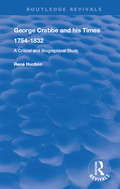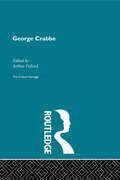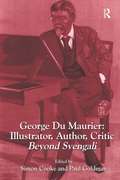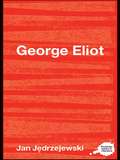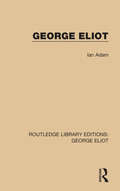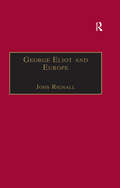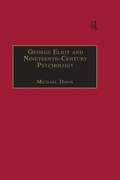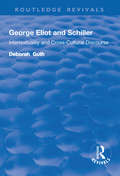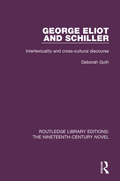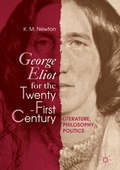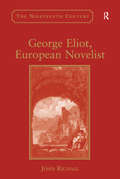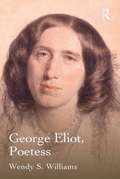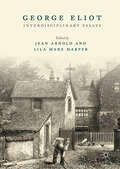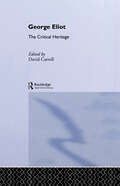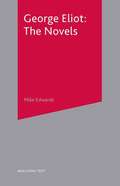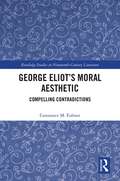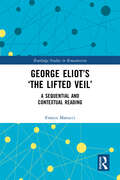- Table View
- List View
George Crabbe and his Times 1754-1832: A Critical and Biographical Study (Routledge Revivals)
by René HuchonThis book was first published in 1968 First appearing in 1907, René Huchon with the help of original manuscripts rewrote the biography of Crabbe published by his son in 1834. As the title suggests, however, Huchon was not merely concerned with the presentation of Crabbe as a literary figure in isolation, and by conjuring up the atmosphere and background of the eighteenth century he is able to shed new light on Crabbe's poetry.There are descriptions of Aldborough, of the desolate heaths and marshy wastes where Crabbe spent his unhappy youth, which together with his background of poverty, and familiarity with the life of the country poor, led him to revolt against the current trend of pastoral poetry. At the time the most detailed study of Crabbe, this work is of foremost importance, for rarely is a poety placed so securely in his setting, and both followers of the poet, and devotees of the eighteenth century will welcome this being freely available agian.
George Crabbe: The Critical Heritage
by Arthur PollardFirst published in 2003. Routledge is an imprint of Taylor & Francis, an informa company.
George Du Maurier: Beyond Svengali
by Simon Cooke Paul GoldmanThough well-known as the author of Trilby and the creator of Svengali, the writer-artist George Du Maurier had many other accomplishments that are less familiar to modern audiences. This collection traces Du Maurier’s role as a participant in the wider cultural life of his time, restoring him to his proper status as a major Victorian figure. Divided into sections, the volume considers Du Maurier as an artist, illustrator and novelist who helped to form some of the key ideas of his time. The contributors place his life and work in the context of his treatment of Judaism and Jewishness; his fascination with urbanization, Victorian science, technology and clairvoyance; his friendships and influences; and his impact on notions of consumerism and taste. As an illustrator, Du Maurier collaborated with Thomas Hardy, Elizabeth Gaskell and sensational writers such as M. E. Braddon and the author of The Notting Hill Mystery. These partnerships, along with his reflections on the art of illustration, are considered in detail. Impossible to categorize, Du Maurier was an Anglo-Frenchman with cultural linkages in France, England, and America; a social commentator with an interest in The New Woman; a Punch humourist; and a friend of Henry James, with whom he shared a particular interest in the writing of domesticity and domestic settings. Closing with a consideration of Du Maurier’s after-life, notably the treatment of his work in film, this collection highlights his diverse achievements and makes a case for his enduring significance.
George Egerton: Terra Incognitas (Among the Victorians and Modernists)
by Whitney Standlee Isobel SigleyGeorge Egerton: Terra Incognitas is the first published work to focus solely on Egerton and her literary legacy. It covers the range and extent of Egerton's life and literary career from her emergence into the milieu of London publishing in 1893 to her dramatic works (both original and in translation) and their performance history into the 1920s. This work is an essential addition to ongoing recovery projects and is the first to focus on her 'lost' and unpublished works, mentorship of younger writers, her experiments with characterisations and themes, sociopolitical stances, innovations with form and content, and ultimately, her literary legacy. In doing so, George Egerton: Terra Incognitas reassesses Egerton's broader contribution to fin-de-siècle and early-twentieth-century literature and drama and repositions her as among the most important of the literary innovators of period, and a noteworthy precursor to later female literary modernisers, including Katherine Mansfield, Dorothy Richardson, Elizabeth Bowen and Virginia Woolf.
George Eliot
by Jennifer UglowThis biography of one of the greatest English novelists sheds important new light on George Eliot's audacious life and powerful works, including such masterpieces as "Middlemarch" and "The Mill on the Floss". In her own lifetime, Eliot was widely condemned as a fallen woman: she dared to live openly with a man she could never marry, and shortly after his death married a man twenty years her junior. Her defiance of the conventions that ruled most Victorian women's lives did not prevent her achieving both great professional success and personal happiness. Why, then, did she deny so many of her gifted, headstrong heroines the same opportunities?
George Eliot
by K. K. CollinsWith over 200 fully annotated selections, this volume provides a fresh, vivid portrait of a great Victorian novelist in the words of some 150 persons who knew, met or saw her -family members, close friends (and their children), chance acquaintances, childhood schoolmates, dinner companions, famous contemporaries, university men and women, gallery and concert-hall onlookers, and curious Americans. The entries range in length from a few sentences to a few pages, in tone from gushing adoration to biting condemnation, and in origin from manuscript letters and diaries to published works. Complementing well known recollections are dozens of 'new' ones not found in George Eliot's biographies. Altogether they afford an unmatched view of a controversial genius whose irregular domestic life - twenty-five years' cohabitation with a man she could not marry - led to so fiercely guarded a privacy that meeting her seemed an event of mythic proportions. "
George Eliot (Routledge Guides to Literature)
by Jan JedrzejewskiAs a woman in an illegal marriage, publishing under a male pseudonym, George Eliot was one of the most successful yet controversial writers of the Victorian period. Today she is considered a key figure for women’s writing and her novels, including The Mill on the Floss and Middlemarch, are commonly ranked as literary classics. This guide to Eliot’s enduringly popular work offers: an accessible introduction to the contexts and many interpretations of Eliot’s texts, from publication to the present an introduction to key critical texts and perspectives on Eliot’s life and work, situated in a broader critical history cross-references between sections of the guide, in order to suggest links between texts, contexts and criticism suggestions for further reading. Part of the Routledge Guides to Literature series, this volume is essential reading for all those beginning detailed study of George Eliot and seeking not only a guide to her works but also a way through the wealth of contextual and critical material that surrounds them.
George Eliot (Routledge Library Editions: George Eliot #1)
by Ian AdamFirst published in 1969. George Eliot is a writer of ordinary human experience, whose work emphasizes commonplace characters and commonplace situations. Her mind, however, was far from ordinary. Professor Adam shows how wit, observation and sympathy, combined with a lucid and energetic intelligence, enabled her to invest the commonplace with complexity and importance. Extracts from George Eliot’s major novels illustrate her treatment of character, setting, dialogue and narrative, while the author’s commentary discusses the particulars of her artistic procedures and techniques. This title will be of interest to students of literature.
George Eliot and Europe (Warwick Studies in the Humanities)
by John RignallThis book is based on a conference held in Warwick in July 1995. It is a collection of essays which explore various aspects of George Eliot's relation to the literature and culture of Continental Europe. The essays range widely over the novelist's life and work, examining her Journals and Impressions of Theophratus Such as well as her novels, and focusing on different countries and cultures, including not only France, Germany and Italy, but also Holland and Spain. Some essays examine the complex general issues of language and culture raised in her work, while others concentrate on her response to specific European writers and texts. There are investigations of intertextualities and possibilities of influence, as well as contextual discussions and comparative readings of her novels alongside works by European writers. The overall effect is to illuminate her writing by setting it in the wider European context which, with her knowledge of languages, her travels and her extraordinary wide reading, she knew so well.
George Eliot and Money
by Dermot ColemanUnlike other Victorian novelists George Eliot rarely incorporated stock market speculation and fraud into her plots, but meditations on money, finance and economics, in relation both to individual ethics and to wider social implications, infuse her novels. This volume examines Eliot's understanding of money and economics, its bearing on her moral and political thought, and the ways in which she incorporated that thought into her novels. It offers a detailed account of Eliot's intellectual engagements with political economy, utilitarianism, and the new liberalism of the 1870s, and also her practical dealings with money through her management of household and business finances and, in later years, her considerable investments in stocks and shares. In a wider context, it presents a detailed study of the ethics of economics in nineteenth-century England, tracing the often uncomfortable relationship between morality and economic utility experienced by intellectuals of the period.
George Eliot and Nineteenth-Century Psychology: Exploring the Unmapped Country (The Nineteenth Century Series)
by Michael DavisIn his study of Eliot as a psychological novelist, Michael Davis examines Eliot's writings in the context of a large volume of nineteenth-century scientific writing about the mind. Eliot, Davis argues, manipulated scientific language in often subversive ways to propose a vision of mind as both fundamentally connected to the external world and radically isolated from and independent of that world. In showing the alignments between Eliot's work and the formulations of such key thinkers as Herbert Spencer, Charles Darwin, T. H. Huxley, and G. H. Lewes, Davis reveals how Eliot responds both creatively and critically to contemporary theories of mind, as she explores such fundamental issues as the mind/body relationship, the mind in evolutionary theory, the significance of reason and emotion, and consciousness. Davis also points to important parallels between Eliot's work and new and future developments in psychology, particularly in the work of William James. In Middlemarch, for example, Eliot demonstrates more clearly than either Lewes or James the way the conscious self is shaped by language. Davis concludes by showing that the complexity of mind, which Eliot expresses through her imaginative use of scientific language, takes on a potentially theological significance. His book suggests a new trajectory for scholars exploring George Eliot's representations of the self in the context of science, society, and religious faith.
George Eliot and Schiller: Intertextuality and Cross-Cultural Discourse (Routledge Library Editions: The Nineteenth-century Novel Ser. #18)
by Deborah GuthThis title was first published in 2003. Though Friedrich Schiller enjoyed prominent literary standing and great popularity in nineteenth century literary England, his influence has been largely neglected in recent scholarship on the period. With George Eliot and Schiller: Intertextuality and Cross-Cultural Discourse, Deborah Guth explores the substantial evidence of the importance of the playwright and philosopher's thought to Eliot's novelistic art. Guth demonstrates the relationship of Schiller's work to Eliot's plotting of moral vision, the tensions in her work between realism and idealism (which an understanding of Schiller redefines substantially), and her aesthetics. The specific focus of the study is the Schillerian subtext of George Eliot's work and a resultant reassessment of her realism. However, the intertextual methodology, applications of Iser's thinking on the translatability of cultures, and a placement of Eliot in a German context serve as a gateway for reconsidering Eliot's contributions in these areas, as well. While recent scholarship on Eliot has focused on gender analysis, New Historicism and cultural materialism, the frame remains largely English. Guth contends that the immense continental underpinnings of Eliot's writing should lead us to re-situate her beyond national boundaries, and view her as a major European, as well as English, writer.
George Eliot and Schiller: Intertextuality and cross-cultural discourse (Routledge Library Editions: The Nineteenth-Century Novel #18)
by Deborah GuthThough Friedrich Schiller enjoyed prominent literary standing and great popularity in nineteenth century literary England, his influence has been largely neglected in recent scholarship on the period. First published in 2003, this book explores the substantial evidence of the importance of the playwright and philosopher’s thought to George Eliot’s novelistic art. It demonstrates the relationship between Schiller’s work and Eliot’s plotting of moral vision, the tensions in her work between realism and idealism, and her aesthetics. It also contends that the immense continental underpinnings of Eliot’s writing should lead us to resituate her beyond national boundaries, and view her as a major European, as well as English, writer. This book will be of interest to those studying 19th Century English and European literature.
George Eliot and the Landscape of Time: Narrative Form and Protestant Apocalyptic History
by Mary Wilson CarpenterCarpenter discusses apocalytptic narrative schemes in Romola, Adam Bede, Middlemarch, Daniel Deronda, and The Legend of Jubal. In the context of nineteenth-century British interpretation of the prophesies, this study reveals an unsuspected visionary poetics in Eliot's writings and demonstrates that her later works rewrite Protestant apocalyptics in both romantic and satiric styles, suggesting a new approach to Victorian narrative form.Originally published in 1986.A UNC Press Enduring Edition -- UNC Press Enduring Editions use the latest in digital technology to make available again books from our distinguished backlist that were previously out of print. These editions are published unaltered from the original, and are presented in affordable paperback formats, bringing readers both historical and cultural value.
George Eliot for the Twenty-First Century: Literature, Philosophy, Politics
by K. M. NewtonGeorge Eliot for the Twenty-First Century reexamines Eliot two hundred years after her birth and offers an innovative critical reading that seeks to change perceptions of Eliot. Tracing Eliot’s literary reception from the nineteenth century to the late twentieth and early twenty-first century, K. M. Newton frames Eliot as an unorthodox radical and considers the philosophical, ethical, political, and artistic subtleties permeating her writings. Drawing from close readings of her novels, essays, and letters, Newton offers a new critical perspective on George Eliot and reveals her enduring relevance in the twenty-first century.
George Eliot in Context
by Margaret HarrisProdigiously learned, alive to the massive social changes of her time, defiant of many Victorian orthodoxies, George Eliot has always challenged her readers. She is at once chronicler and analyst, novelist of nostalgia and monumental thinker. In her great novel Middlemarch she writes of 'that tempting range of relevancies called the universe'. This volume identifies a range of 'relevancies' that inform both her fictional and her non-fictional writings. The range and scale of her achievement are brought into focus by cogent essays on the many contexts – historical, intellectual, political, social, cultural – to her work. In addition there are discussions of her critical history and legacy, as well as of the material conditions of production and distribution of her novels and her journalism. The volume enables fuller understanding and appreciation, from a twenty-first-century standpoint, of the life and work of one of the nineteenth century's major writers.
George Eliot in Germany, 1854–55: 'Cherished Memories' (The Nineteenth Century Series)
by Gerlinde Roder-BoltonFrom 1854 to 1855, George Eliot spent eight months in Germany, a period that marked the start of her life with George Lewes. Though Eliot documented this journey more extensively than any other, it has remained an under-researched part of Eliot's biography. In her meticulously documented and engaging book, Gerlinde Röder-Bolton draws on Eliot's own writings, as well as on extensive original research in German archives and libraries, to provide the most thorough account yet published of the couple's visit. Rich in historical, social, and cultural detail, George Eliot in Germany, 1854-55 not only records the couple's travels but supplies a context for their encounters with people and places. In the process, Röder-Bolton shows how the crossing of geographical boundaries may be read as symbolic of Eliot's transition from single woman to social outcast and from translator and critic to writer of fiction.
George Eliot's English Travels: Composite Characters and Coded Communications
by Kathleen McCormackGeorge Eliot’s more than fifty long and short journeys within England took her to dozens of sites scattered around the country. Revising the traditional notion that George Eliot drew her settings and characters only from the areas of her Warwickshire childhood, Kathleen McCormack demonstrates that English travel furnished the novelist with a wide variety of originals for the composite characters and settings she would so memorably create. McCormack traces the way in which George Eliot gathered material during her travels and also drafted long sections of the novels while away from her London home. She argues that by examining the choices George Eliot made in transforming, discarding or directly describing her English originals, we might take a significant step forward in the interpretation of her writings. Where other critics have tried to interpret characters as one-to-one renderings of living or dead models, for example, this study reveals more elaborate blendings of what George Eliot called the ‘widely sundered elements’ that made up her fiction. McCormack also reaches the fascinating conclusion that the novels were a form of coded communication between the author and people in her life, including other prominent Victorians such as Edward Burne-Jones, Robert Lytton and Barbara Bodichon. Presenting fresh biographical information and original insights into George Eliot’s writing strategies, George Eliot’s English Travels promises a decisive shift in our understanding of one of the most important figures in Victorian literature.
George Eliot, European Novelist (The\nineteenth Century Ser.)
by John RignallReading George Eliot as a European novelist among other European novelists, John Rignall explores her use of European travel, scenes and locations in her fiction and also places her novels in conversation with the work of other major European writers. Throughout the book, Rignall shows Eliot's engagement with the cultures of France and Germany, suggestively making the case that Eliot's novels belong to the tradition of the European novel that descends from Cervantes. Rignall develops the fundamental theme of Eliot's position as a European novelist in chapters that explore the significance of Eliot's first visit to Germany with G. H. Lewes, Eliot's ideas on the cultural differences between French and German writing, the incidental part travel plays in novels such as Daniel Deronda and Middlemarch, the role of European landscapes in her fiction, the dialogical relationship between Eliot and Balzac, comparisons between Middlemarch and Flaubert's Madame Bovary, and connections between the novels of Eliot, Gottfried Keller and Theodor Fontane. Daniel Deronda is examined both within the wider context of European Jewish life and as part of a tradition of French novels that harkens back to Balzac and anticipates Proust. Rignall's final chapter takes up Nietzsche's notorious criticism of Eliot in Twilight of the Idols, showing that Eliot, with her sceptical intelligence, insight into the essentially metaphorical nature of language, and grasp of modernity, has something in common with this philosophical iconoclast.
George Eliot, Poetess
by Wendy S. WilliamsThe position of George Eliot’s poetry within Victorian poetry and within her own canon is crucial for an accurate picture of the writer, as Wendy S. Williams shows in her in-depth examination of Eliot’s poetry and her role as poetess. Williams argues that even more clearly than her fiction, Eliot’s poetry reveals the development of her belief in sympathy as a replacement for orthodox religious views. With knowledge of the Bible and a firm understanding of society’s expectations for female authorship, Eliot consciously participated in a tradition of women poets who relied on feminine piety and poetry to help refine society through compassion and fellow-feeling. Williams examines Eliot’s poetry in relationship to her gender and sexual politics and her shifting religious beliefs, showing that Eliot’s views on gender and religion informed her adoption of the poetess persona. By taking into account Eliot’s poetess treatment of community and motherhood, Williams suggests, readers come to view her not only as a writer of fiction, an intellectual, and a social commentator, but also as a woman who longed to nurture, participate in, and foster human relationships.
George Eliot: Interdisciplinary Essays
by Jean Arnold Lila Marz HarperThis collection brings together new articles by leading scholars who reappraise George Eliot in her bicentenary year as an interdisciplinary thinker and writer for our times. Here, researchers, students, teachers and the general public gain access to new perspectives on Eliot’s vast interests and knowledge, informed by the nineteenth-century British culture in which she lived. Examining Eliot’s wide-ranging engagement with Victorian historical research, periodicals, poetry, mythology, natural history, realism, the body, gender relations, and animal studies, these essays construct an exciting new interdisciplinary agenda for future Eliot studies.
George Eliot: The Critical Heritage (The\critical Heritage Ser.)
by David CarrollThe Critical Heritage gathers together a large body of critical sources on major figures in literature. Each volume presents contemporary responses to a writer's work, enabling students and researchers to read for themselves, for example, comments on early performances of Shakespeare's plays, or reactions to the first publication of Jane Austen's novels.The carefully selected sources range from landmark essays in the history of criticism to journalism and contemporary opinion, and little published documentary material such as letters and diaries. Significant pieces of criticism from later periods are also included, in order to demonstrate the fluctuations in an author's reputation.Each volume contains an introduction to the writer's published works, a selected bibliography, and an index of works, authors and subjects.The Collected Critical Heritage set will be available as a set of 68 volumes and the series will also be available in mini sets selected by period (in slipcase boxes) and as individual volumes.
George Eliot: The Novels
by Mike EdwardsThis volume guides students through Eliot's most widely studied novels: The Mill on the Floss, Silas Marner and Middlemarch. The first part of the book is based on analysis of extracts grouped by themes including relationships, society and morality. At the end of each chapter, a 'Methods' section offers ideas for independent study. The second part describes Eliot's biographical, cultural and intellectual environment, and gives readings of representative critical writing.
George Eliot’s Moral Aesthetic: Compelling Contradictions (Routledge Studies in Nineteenth Century Literature)
by Constance M. FulmerGeorge Eliot’s serious readers have been intrigued by the fact that she declared that she had lost her faith in God and had renounced her hope for a traditional Christian heaven and yet she continued to preach her own version of morality in everything she wrote, to hope for an immortality which allowed her to join an invisible choir which would influence generations to come, and to be concerned about the moral growth of her characters. This is only one of the many compelling contradictions in her life and in her artistry. This volume aims to investigate Eliot’s ethical and artistic principles by defining her moral aesthetic as it relates to her self-concept and exploring Eliot’s narrative decisions and the decisions made by her characters and the circumstances which prompt those choices. Dr. Fulmer includes chapters on her clerical figures and other types of individuals such as musicians, and politicians. Dr. Fulmer also illuminates the paradoxes and contradictions in George Eliot’s life and in her philosophy by focusing on Eliot's use of animals, mirrors, windows, jewelry, wills and other tangible images in her poetry as well as her novels. George Eliot’s Moral Aesthetic contends that everything about her moral philosophy is related to her writing and that everything about her writing is related to her moral philosophy.
George Eliot’s ‘The Lifted Veil’: A Sequential and Contextual Reading (Routledge Studies in Romanticism)
by Franco MarucciThe negative historical judgment given to George Eliot’s ‘The Lifted Veil’ amounts nowadays to a gross critical blunder, and in the last three decades the story has been firmly reinstated in Eliot’s major canon. The premise of the present book is that George Eliot’s oeuvre is a compact macrotext where themes, motifs, patterns and cultural and personal archetypes recur with variations, and that ‘The Lifted Veil’ functions as the linchpin of this oeuvre. A sequential approach to the story is authorized by the use of a mimetic enunciation that simulates a gradual ‘definition’ of events, places, and characters as they have appeared to the narrating ‘I’ in the course of time until the moment of the enunciation. Contextualizing ‘The Lifted Veil’ means placing it within Eliot’s oeuvre and against the background of Victorian mid-century fiction; in a further meaning, seeing it as intersecting various contemporary genres and subgenres, such as that of the European and American ‘literature of the veil’, that of the archetypal icon of the femme fatale, that of Wilkie Collins’s ‘dead secret’ novels. The most significant facet that critical literature on ‘The Lifted Veil’ has tended to overlook is however the encrypting of the experience of a failed religious conversion and the foreshadowing of the search for a spiritual and racial identity of Daniel Deronda, the hero of Eliot’s final novel.
